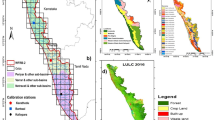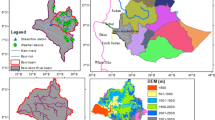Abstract
The aim of this study was to investigate the impacts of future climate change on discharge and evapotranspiration of the Upper Blue Nile (UBN) basin using multiple global circulation models (GCMs) projections and multiple hydrological models (HMs). The uncertainties of projections originating from HMs, GCMs, and representative concentration pathways (RCPs) were also analyzed. This study is part of the Inter-Sectoral Impact Model Intercomparison Project (ISI-MIP) initiative (phase 2), which is a community driven modeling effort to assess global socio-economic impacts of climate change. The baseline period of 1981–2010 was used to identify climate change signals in two future periods: mid future (2036–2065) and far future (2070–2099). Our analyses showed that two out of four GCMs indicated a statistically significant increase in projected precipitation in the far future period. The projected change in mean annual precipitation varied between 4 and 10% relative to the baseline period. The HMs did not agree on the direction of climate change impacts on mean annual discharge. Furthermore, simulated changes in mean annual discharge by all HMs, except SWIM which simulated up to 6.6% increase for the far future period, were not statistically significant. All the HMs generally simulated a statistically significant increase in annual mean actual evapotranspiration (AET) in both periods. The HMs simulated changes in AET ranging from 1.9 to 4.4% for the far future period. In the UBN basin GCM structure was the main contributor of uncertainty in mean annual discharge projection followed by HM structure and RCPs, respectively. The results from this research suggest to use multiple impact models as well as multiple GCMs to provide a more robust assessment of climate change impacts in the UBN basin.





Similar content being viewed by others
References
Aich V, Liersch S, Vetter T et al (2014) Comparing impacts of climate change on streamflow in four large African river basins. Hydrol Earth Syst Sci 18:1305–1321. doi:10.5194/hess-18-1305-2014
Alcamo J, Döll P, Henrichs T et al (2003) Development and testing of the WaterGAP 2 global model of water use and availability. Hydrol Sci J 48:317–337. doi:10.1623/hysj.48.3.317.45290
Alemayehu T, van Griensven A, Bauwens W (2015) Evaluating CFSR and WATCH data as input to SWAT for the estimation of the potential evapotranspiration in a data-scarce Eastern-African catchment. J Hydrol Eng 21:05015028. doi:10.1061/(ASCE)HE.1943-5584.0001305
Arnold JG, Srinivasan R, Muttiah RS, Williams JR (1998) Large area hydrologic modeling and assessment part I: model development1. JAWRA J Am Water Resour Assoc 34:73–89. doi:10.1111/j.1752-1688.1998.tb05961.x
Berhane F, Zaitchik B, Dezfuli A (2013) Subseasonal analysis of precipitation variability in the Blue Nile River basin. J Clim 27:325–344. doi:10.1175/JCLI-D-13-00094.1
Beyene T, Lettenmaier DP, Kabat P (2009) Hydrologic impacts of climate change on the Nile River basin: implications of the 2007 IPCC scenarios. Clim Change 100:433–461. doi:10.1007/s10584-009-9693-0
Chen J, Brissette FP, Poulin A, Leconte R (2011) Overall uncertainty study of the hydrological impacts of climate change for a Canadian watershed. Water Resour Res 47:W12509. doi:10.1029/2011WR010602
Christensen NS, Lettenmaier DP (2007) A multimodel ensemble approach to assessment of climate change impacts on the hydrology and water resources of the Colorado River Basin. Hydrol Earth Syst Sci 11:1417–1434. doi:10.5194/hess-11-1417-2007
Conway D (1996) The impacts of climate variability and future climate change in the Nile Basin on water resources in Egypt. Int J Water Resour Dev 12:277–296. doi:10.1080/07900629650178
Conway D, Hulme M (1993) Recent fluctuations in precipitation and runoff over the Nile sub-basins and their impact on main Nile discharge. Clim Change 25:127–151. doi:10.1007/BF01661202
Elshamy ME, Seierstad IA, Sorteberg A (2009) Impacts of climate change on Blue Nile flows using bias-corrected GCM scenarios. Hydrol Earth Syst Sci 13:551–565. doi:10.5194/hess-13-551-2009
Elshamy M, Baldassarre G, Griensven A (2012) Characterizing climate model uncertainty using an informal Bayesian framework: application to the River Nile. J Hydrol Eng 18:582–589. doi:10.1061/(ASCE)HE.1943-5584.0000656
Exbrayat J-F, Buytaert W, Timbe E et al (2014) Addressing sources of uncertainty in runoff projections for a data scarce catchment in the Ecuadorian Andes. Clim Change 125:221–235. doi:10.1007/s10584-014-1160-x
Giuntoli I, Vidal J-P, Prudhomme C, Hannah DM (2015) Future hydrological extremes: the uncertainty from multiple global climate and global hydrological models. Earth Syst Dynam 6:267–285. doi:10.5194/esd-6-267-2015
Gosling SN, Taylor RG, Arnell NW, Todd MC (2011) A comparative analysis of projected impacts of climate change on river runoff from global and catchment-scale hydrological models. Hydrol Earth Syst Sci 15:279–294. doi:10.5194/hess-15-279-2011
Gudmundsson L, Wagener T, Tallaksen LM, Engeland K (2012) Evaluation of nine large-scale hydrological models with respect to the seasonal runoff climatology in Europe. Water Resour Res 48:W11504. doi:10.1029/2011WR010911
Hagemann S, Chen C, Clark DB et al (2013) Climate change impact on available water resources obtained using multiple global climate and hydrology models. Earth Syst Dynam 4:129–144. doi:10.5194/esd-4-129-2013
Hempel S, Frieler K, Warszawski L et al (2013) A trend-preserving bias correction—the ISI-MIP approach. Earth Syst Dynam 4:219–236. doi:10.5194/esd-4-219-2013
Huang S, Kumar R, Flörke M, et al (2016) Evaluation of an ensemble of regional hydrological models in 12 large-scale river basins worldwide. Climatic Change 1–17. doi:10.1007/s10584-016-1841-8
IPCC (2014) Climate Change 2014 Mitigation of Climate Change Working Group III Contribution to the Fifth Assessment Report of the Intergovernmental Panel on Climate Change
Jiang T, Chen YD, Xu C et al (2007) Comparison of hydrological impacts of climate change simulated by six hydrological models in the Dongjiang Basin, South China. J Hydrol 336:316–333. doi:10.1016/j.jhydrol.2007.01.010
Kay AL, Davies HN (2008) Calculating potential evaporation from climate model data: a source of uncertainty for hydrological climate change impacts. J Hydrol 358:221–239. doi:10.1016/j.jhydrol.2008.06.005
Krysanova V, Müller-Wohlfeil D-I, Becker A (1998) Development and test of a spatially distributed hydrological/water quality model for mesoscale watersheds. Ecol Model 106:261–289. doi:10.1016/S0304-3800(97)00204-4
Kumar R, Samaniego L, Attinger S (2013) Implications of distributed hydrologic model parameterization on water fluxes at multiple scales and locations. Water Resour Res 49:360–379. doi:10.1029/2012WR012195
Liang XUDPL (1994) A simple hydrologically based model of land surface water and energy fluxes for GSMs. J Geophys Res. doi:10.1029/94JD00483
Lindström G, Johansson B, Persson M et al (1997) Development and test of the distributed HBV-96 hydrological model. J Hydrol 201:272–288. doi:10.1016/S0022-1694(97)00041-3
Mengistu DT, Sorteberg A (2012) Sensitivity of SWAT simulated streamflow to climatic changes within the Eastern Nile River basin. Hydrol Earth Syst Sci 16:391–407. doi:10.5194/hess-16-391-2012
Moss RH, Edmonds JA, Hibbard KA et al (2010) The next generation of scenarios for climate change research and assessment. Nature 463:747–756. doi:10.1038/nature08823
Nawaz R, Bellerby T, Sayed M, Elshamy M (2010) Blue Nile runoff sensitivity to climate change
Poulin A, Brissette F, Leconte R et al (2011) Uncertainty of hydrological modelling in climate change impact studies in a Canadian, snow-dominated river basin. J Hydrol 409:626–636. doi:10.1016/j.jhydrol.2011.08.057
Samaniego L, Kumar R, Attinger S (2010) Multiscale parameter regionalization of a grid-based hydrologic model at the mesoscale. Water Resour Res 46:W05523. doi:10.1029/2008WR007327
Sheffield J, Wood EF (2008) Projected changes in drought occurrence under future global warming from multi-model, multi-scenario, IPCC AR4 simulations. Clim Dyn 31:79–105. doi:10.1007/s00382-007-0340-z
Taye MT, Ntegeka V, Ogiramoi NP, Willems P (2011) Assessment of climate change impact on hydrological extremes in two source regions of the Nile River Basin. Hydrol Earth Syst Sci 15:209–222. doi:10.5194/hess-15-209-2011
Thompson JR, Green AJ, Kingston DG (2014) Potential evapotranspiration-related uncertainty in climate change impacts on river flow: an assessment for the Mekong River basin. J Hydrol 510:259–279. doi:10.1016/j.jhydrol.2013.12.010
Vetter T, Huang S, Aich V et al (2015) Multi-model climate impact assessment and intercomparison for three large-scale river basins on three continents. Earth Syst Dynam 6:17–43. doi:10.5194/esd-6-17-2015
Weedon GP, Gomes S, Viterbo P et al (2011) Creation of the WATCH forcing data and its use to assess global and regional reference crop evaporation over land during the twentieth century. J Hydrometeorol 12:823–848. doi:10.1175/2011JHM1369.1
Yates D, Strzepek K (1998) Modeling the Nile Basin under climatic change. J Hydrol Eng 3:98–108. doi:10.1061/(ASCE)1084-0699(1998)3:2(98)
Author information
Authors and Affiliations
Corresponding author
Additional information
This article is part of a Special Issue on “Hydrological Model Intercomparison for Climate Impact Assessment” edited by Valentina Krysanova and Fred Hattermann.
Rights and permissions
About this article
Cite this article
Teklesadik, A.D., Alemayehu, T., van Griensven, A. et al. Inter-model comparison of hydrological impacts of climate change on the Upper Blue Nile basin using ensemble of hydrological models and global climate models. Climatic Change 141, 517–532 (2017). https://doi.org/10.1007/s10584-017-1913-4
Received:
Accepted:
Published:
Issue Date:
DOI: https://doi.org/10.1007/s10584-017-1913-4




